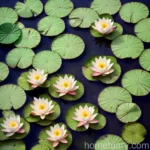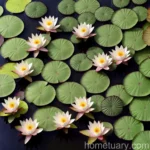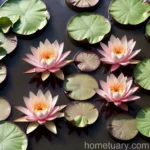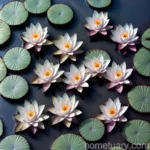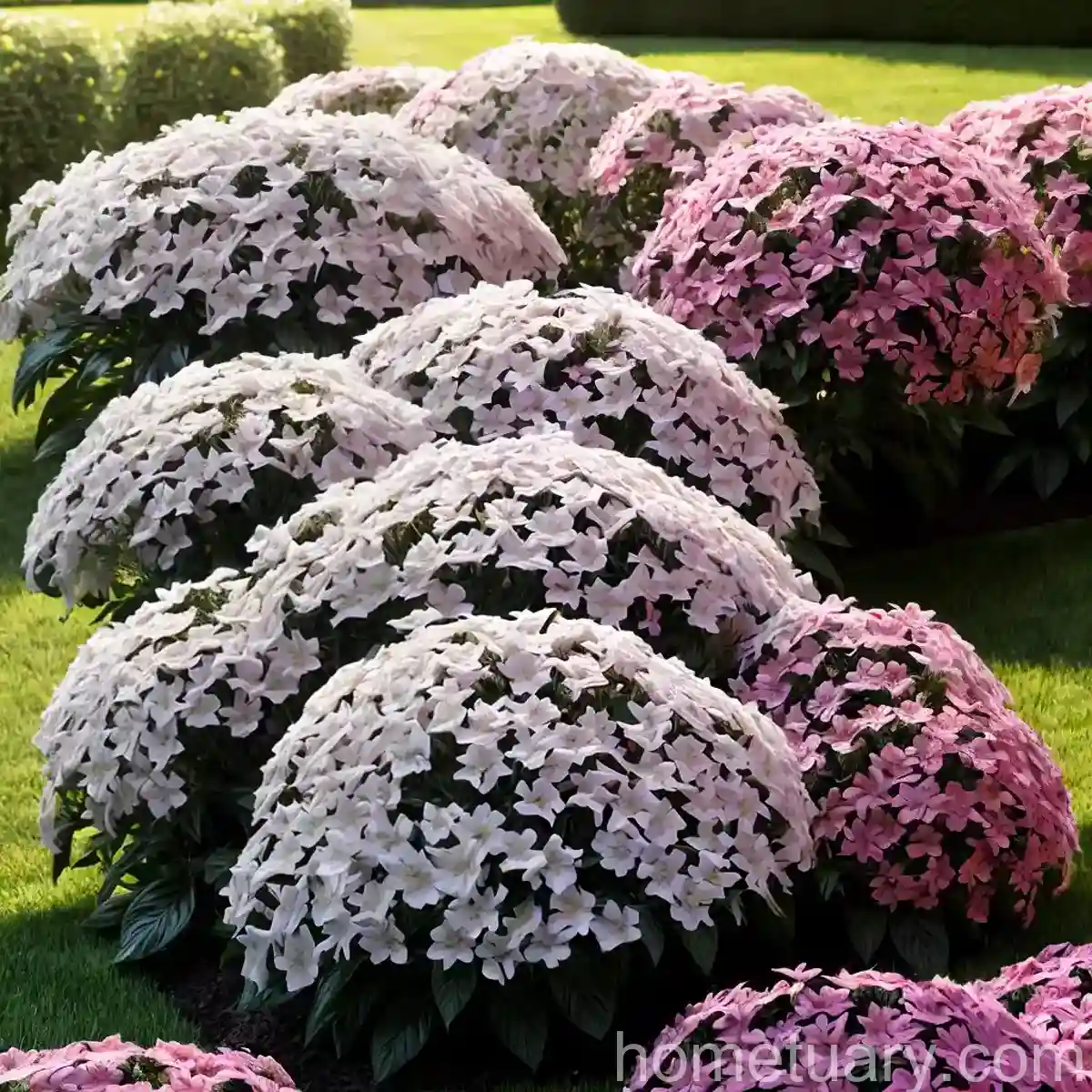Egyptian Blue Water Lily (Nymphaea caerulea): A Fascinating Plant with Rich Cultural History and Remarkable Uses
As a plant scientist, I have always been captivated by the sheer diversity and beauty of plants. Moreover, learning about the cultural significance and varied uses of plants across different civilizations has been an enriching experience. In this article, I am excited to delve into the world of the Egyptian blue water lily (Nymphaea caerulea), a remarkable plant with deep-rooted connections to ancient Egypt and a wide array of cultural, medicinal, and practical applications. From its historic importance to its cultivation, uses, and intriguing folklore, we will explore every facet of this captivating plant.
What is the Egyptian Blue Water Lily (Nymphaea caerulea)?
The Egyptian blue water lily, scientifically known as Nymphaea caerulea, is a stunning aquatic plant that belongs to the family Nymphaeaceae. It is native to parts of East Africa, including Egypt, and thrives in freshwater habitats such as ponds, lakes, and slow-moving rivers. The plant is renowned for its vibrant blue flowers and lily pads, making it a visually striking addition to aquatic environments.
Key Takeaways – Egyptian Blue Water Lily (Nymphaea caerulea)
Before we delve into the various aspects of the Egyptian blue water lily, let’s outline the key takeaways that we will explore in detail throughout this article:
- Plant Name: Egyptian Blue Water Lily (Nymphaea caerulea)
- Culture
- Uses
- Medicinal
- Cultural
- Practical
- Growing Conditions
- Water
- Sunlight
- Soil
- Fertilization
- Pruning
- Propagation
- Container Cultivation
- Popularity
- Common Diseases
- Common Pests
- Botanist’s Tips
- Fun Facts
- Links to External Resources
With these key takeaways in mind, let’s embark on a comprehensive journey into the world of the Egyptian blue water lily, exploring its diverse cultural significance, benefits, and practical considerations for cultivation.
Culture of the Egyptian Blue Water Lily
Egyptian Blue Lotus Flower in History and Mythology
The Egyptian blue water lily holds immense cultural significance, particularly in ancient Egyptian history and mythology. Revered as a symbol of creation and rebirth, the blue water lily was associated with the sun god Ra and the process of emergence from the waters of chaos. It was also believed to possess mystical and psychoactive properties, leading to its portrayal in various ancient Egyptian art forms and religious ceremonies.
The blue water lily was frequently depicted in hieroglyphs and ancient artifacts, signifying its prominent role in the spiritual and cultural landscape of ancient Egypt. Its symbolic association with rebirth and spiritual transformation reflects the profound reverence that the ancient Egyptians held for this captivating plant.
Moreover, the blue water lily found its way into various medicinal and herbal practices, serving as a versatile natural remedy and incorporating its soothing and therapeutic properties into ancient Egyptian medicine.
Blue Water Lily Symbolism and Spiritual Significance
In addition to its historical significance, the blue water lily continues to embody profound symbolism and spiritual significance in various cultures. Beyond its association with ancient Egyptian mythology, the plant has been revered for its calming and rejuvenating attributes, signifying peace, serenity, and emotional well-being.
The captivating beauty of the blue water lily and its tranquil aquatic habitat have also made it a potent symbol of relaxation and inner tranquility in contemporary contexts. Its presence in art, literature, and spiritual practices underscores its enduring appeal as a symbol of purity, enlightenment, and spiritual awakening.
Uses of the Egyptian Blue Water Lily
The Egyptian blue water lily offers a broad spectrum of uses that span medicinal, cultural, and practical domains. Let’s explore each of these categories in detail to gain an in-depth understanding of the remarkable applications of this captivating plant.
Medicinal Properties of Nymphaea caerulea
Nymphaea caerulea is renowned for its medicinal properties, which have been recognized and utilized across various cultures throughout history. The plant’s therapeutic potential is associated with its diverse chemical composition, including alkaloids, flavonoids, and other bioactive compounds that contribute to its medicinal efficacy.
Ancient Medicinal Uses
In ancient Egypt, the blue water lily was utilized in traditional medicine for its sedative, analgesic, and anxiolytic properties. It was employed to alleviate anxiety, induce relaxation, and promote restful sleep, reflecting the deep understanding of its medicinal benefits in ancient therapeutic practices.
The plant was also valued for its potential in managing various common ailments, including sleep disorders, stress-related conditions, and emotional disturbances, thereby contributing to the overall well-being and vitality of individuals in ancient times.
Therapeutic Potentials in Modern Medicine
In contemporary times, the therapeutic potential of Nymphaea caerulea continues to garner attention and is being studied for its potential applications in modern medicine. Researchers have investigated its neuropharmacological properties, including its effects on the central nervous system, stress management, and sleep regulation, shedding light on its potential as a natural remedy for various health concerns.
Moreover, the plant’s anti-inflammatory, antioxidative, and analgesic properties have sparked interest in exploring its role in addressing contemporary health challenges, thereby positioning the Egyptian blue water lily as a valuable subject of scientific inquiry and potential source of novel therapeutic agents.
Cultural and Spiritual Significance
The cultural and spiritual significance of the Egyptian blue water lily extends far beyond its medicinal uses, permeating various aspects of art, literature, and spiritual practices. Its representation in ancient Egyptian art and symbolism underscores its enduring cultural resonance and profound impact on artistic expression and spiritual traditions.
The blue water lily’s symbolism as a harbinger of spiritual awakening, inner peace, and emotional well-being has continued to influence its portrayal in contemporary art and cultural contexts, serving as a timeless emblem of serenity, purity, and transcendence.
Practical Applications
Beyond its medicinal and cultural significance, the Egyptian blue water lily offers practical uses that have contributed to its enduring relevance in various domains. From its historical role as a source of natural dyes to its potential as a valuable ornamental plant, the versatility of Nymphaea caerulea extends to practical applications that enrich diverse facets of human life.
Natural Dye Production
The vibrant blue petals of the Egyptian blue water lily have historically been used as a source of natural dye, imparting rich hues to textiles, ceramics, and artistic creations. The plant’s potential as a natural dye source underscores its role in traditional crafts and artistic endeavors, emphasizing its significance in cultural and practical realms.
Ornamental Beauty
The captivating allure of the blue water lily has made it a sought-after ornamental plant, gracing aquatic gardens, ponds, and water features with its exquisite blooms and verdant foliage. Its aesthetic appeal and tranquil presence have positioned it as a cherished element in landscaping and horticultural designs, enhancing the visual beauty of aquatic environments and adding a touch of serenity to outdoor spaces.
Growing Conditions for the Egyptian Blue Water Lily
Water
Being an aquatic plant, the Egyptian blue water lily thrives in freshwater environments, requiring a steady supply of clean water to support its growth and blooming. When cultivating Nymphaea caerulea, it is essential to ensure that the water quality is optimal, free from pollutants and excessive nutrient levels that could diminish the plant’s health and vitality.
Sunlight
In its natural habitat, the blue water lily thrives in locations with ample sunlight, as exposure to sunlight is essential for promoting robust growth and flower production. When introduced to artificial aquatic environments or containers, it is vital to provide the plant with sufficient sunlight to support its photosynthetic processes and overall well-being.
Soil
The ideal soil conditions for cultivating the Egyptian blue water lily should be rich in organic matter and conducive to aquatic plant growth. A mixture of loam and clay can provide a suitable substrate for the plant, offering stability and essential nutrients to sustain its development. When selecting soil for container cultivation, it is crucial to prioritize a well-balanced composition that supports the plant’s root system and overall vigor.
Fertilization
To promote healthy growth and abundant flowering, the Egyptian blue water lily can benefit from periodic fertilization to augment its nutrient intake. Specialized aquatic fertilizers designed for water lilies and aquatic plants can provide the essential elements required for robust growth and prolific blooming, enhancing the plant’s ornamental and aesthetic appeal.
Pruning
Regular pruning is essential for managing the growth of the Egyptian blue water lily and maintaining a balanced and visually appealing appearance. Removal of spent flowers, damaged foliage, and excessive growth can promote the plant’s vitality and prevent overcrowding, ensuring that it continues to thrive and bloom consistently.
Propagation
Propagating the Egyptian blue water lily involves specialized techniques to foster the development of new plants from existing specimens. Methods such as division and rhizome propagation can be employed to propagate the plant, allowing for the expansion of its ornamental and cultural significance in diverse environments.
Container Cultivation
Cultivating the Egyptian blue water lily in containers presents a unique opportunity to introduce this captivating plant into various settings, including ponds, water features, and indoor aquatic environments. By selecting suitable containers and providing the necessary growing conditions, individuals can create stunning aquatic displays featuring the vibrant blooms and serene presence of Nymphaea caerulea.
Popularity of the Egyptian Blue Water Lily
The enduring allure and cultural significance of the Egyptian blue water lily have contributed to its popularity in various capacities. From its role in ancient mythology to its contemporary appeal as an ornamental plant and source of inspiration in art and literature, the blue water lily continues to captivate the imagination and draw widespread admiration for its enchanting beauty and cultural resonance.
Common Diseases of the Egyptian Blue Water Lily
As with any plant, the Egyptian blue water lily is susceptible to certain diseases and health challenges that can affect its growth and vitality. Recognizing these common diseases and implementing appropriate strategies for prevention and management is essential for preserving the health and vigor of Nymphaea caerulea in diverse cultivation settings.
Disease Diagnosis
Identifying and diagnosing diseases that affect the Egyptian blue water lily is crucial for implementing targeted interventions to address specific challenges. Common diseases such as fungal infections, bacterial leaf spots, and water mold infestations can impact the plant’s overall health and necessitate proactive measures to mitigate their effects.
Common Pests
Pests can pose significant threats to the well-being of the Egyptian blue water lily, requiring vigilant monitoring and appropriate pest management strategies to safeguard the plant’s vitality. Understanding the common pests that may target Nymphaea caerulea and implementing integrated pest management approaches are essential for controlling pest populations and preserving the plant’s ornamental and cultural value.
Botanist’s Tips for Cultivating Egyptian Blue Water Lily
As a plant scientist, I am eager to share valuable tips for cultivating the Egyptian blue water lily and enhancing the success of its growth and blooming. By incorporating these expert insights, individuals can elevate their cultivation practices and maximize the ornamental and cultural appeal of Nymphaea caerulea in diverse settings.
- Ensure that the water quality in aquatic environments is optimal for supporting the health and vitality of the blue water lily.
- Provide sufficient sunlight to promote robust growth and prolific flowering, optimizing the plant’s photosynthetic processes and overall well-being.
- Prioritize well-balanced soil compositions to support the Egyptian blue water lily’s root system and nutrient uptake, fostering healthy growth and development.
- Implement regular pruning to manage the plant’s growth and maintain an aesthetically pleasing appearance, enhancing its ornamental and visual appeal.
- Employ specialized propagation techniques to expand the reach and significance of the Egyptian blue water lily in diverse cultural and horticultural contexts.
Fun Facts about the Egyptian Blue Water Lily
In addition to its substantial cultural significance and practical uses, the Egyptian blue water lily boasts an array of captivating and interesting facts that highlight its unique attributes and enduring appeal:
- The blue water lily’s association with ancient Egyptian mythology and spirituality has positioned it as an emblem of rebirth, rejuvenation, and transcendent beauty.
- Nymphaea caerulea’s mesmerizing blue blooms and floating lily pads have inspired numerous artistic expressions and creative interpretations, emphasizing its enduring influence in art and cultural traditions.
- The plant’s medicinal properties, including its role as a natural relaxant and potential stress-relieving agent, showcase its versatile value in addressing contemporary health and wellness concerns.
Links to External Resources
To expand your knowledge and understanding of the Egyptian blue water lily and delve deeper into its cultural significance, growing techniques, and practical applications, I recommend exploring the following external resources:
- The Egyptian Blue Water Lily: Cultural History and Medicinal Uses
- Growing and Caring for the Nymphaea caerulea
- Aquatic Gardening: Incorporating the Egyptian Blue Water Lily
- Traditional and Modern Applications of the Egyptian Blue Water Lily
In conclusion, the Egyptian blue water lily, with its rich cultural history, remarkable uses, and captivating allure, stands as a testament to the enduring influence of plants on human civilization. From its ancient origins to its contemporary significance, Nymphaea caerulea continues to captivate the imagination and inspire admiration for its ornamental, medicinal, and cultural contributions. Embracing the cultural heritage and practical versatility of this extraordinary plant allows us to celebrate its enduring legacy and appreciate the profound connections between plants and human culture throughout history.
As a plant scientist, I compiled a comprehensive guide to the Egyptian blue water lily (Nymphaea caerulea) encompassing its cultural significance, practical uses, growing conditions, and expert insights. I hope this article provides valuable insights into the captivating world of this remarkable plant.




